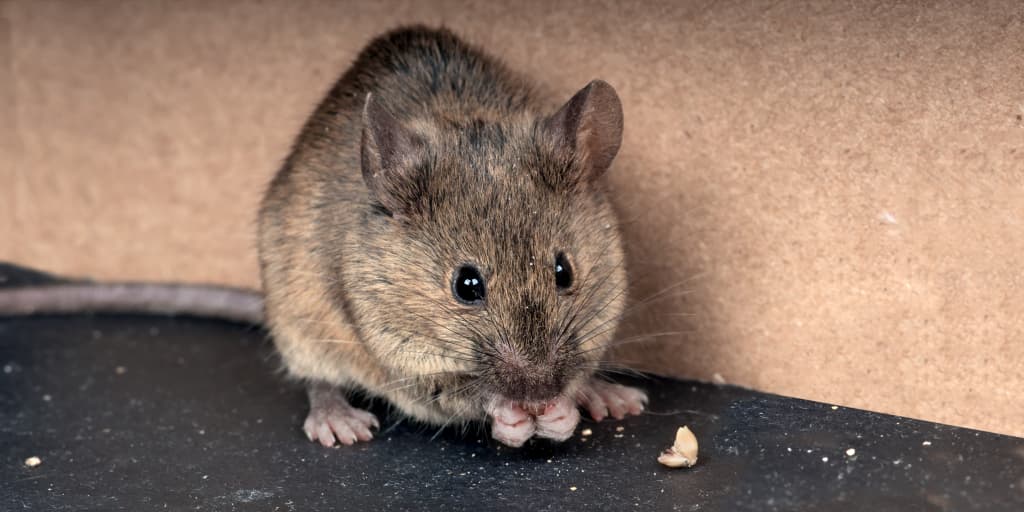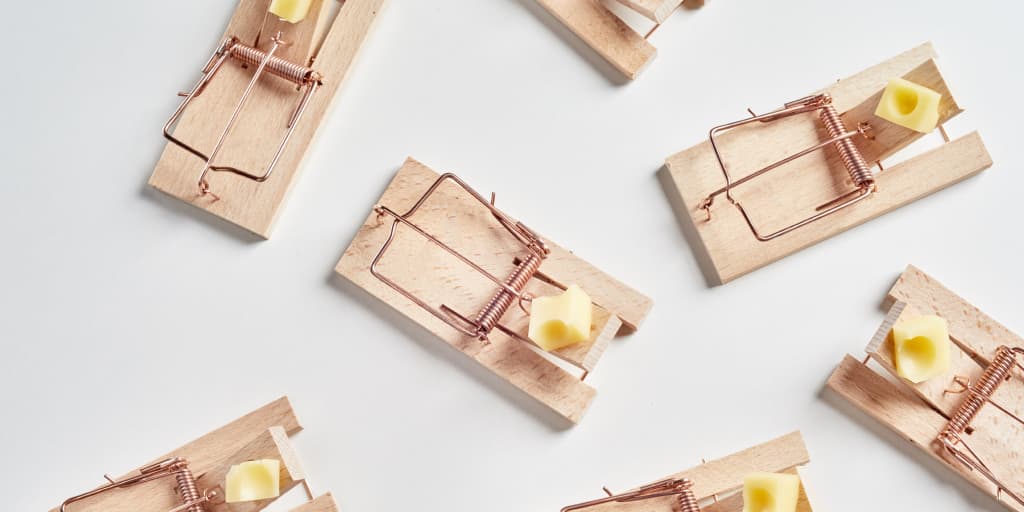Mice! If you’ve had them, you’ll know they’re a pain to eliminate and can multiply quickly. Even if you’ve expelled the majority from your property, more is needed to remove them.
Lofts and underfloor spaces are their favourite hideouts, so you’ll need to pay extra attention to these areas to (finally) evict them.
But don’t worry. This article gives you all the tools and advice to remove mice from your loft, under your floorboards – and anywhere else you might find them.
How do mice even get into your loft or under floors in the first place?
Mice are incredibly agile and small, meaning they can easily fit through cracks and gaps the width of a human finger. Even if there aren’t obvious ‘highways’ into your loft, mice can scramble up there. If you want to know how to get rid of mice in your ceiling, walls or floorboards – you’ll need to pay attention to your whole property.
Here are a few ways mice can get in:
- Wandering across any structures that attach to or connect with your roof or property (e.g. trees, buildings, phone poles)
- Climbing up pipes, drains and gutters
- Squeezing through air vents (or eating away at them to help themselves through)
- Scaling your outer walls
How do you know if mice are in your loft or under floorboards?
Apart from seeing a mouse bolt into a hole when you step into the loft, there are several signs of mice to watch out for:
- Noise! – for such tiny creatures, mice can make a lot of noise. From rustling in plastic bags, to scratching at the floorboards, to telltale squeaking sounds. Hearing any of this is an indication of mice.
- Anything chewed – mice have a habit of chewing through anything – literally anything – they can get their teeth into. You may see holes in boxes, nibbled electrical wires or shredded plastic bags.
- Smell – unpleasant as it is, you may smell a strong, musty scent in the loft. This is often associated with rodents like rats or mice. The more mice there are, the more pungent this smell will be.
- Droppings – it’s easy to spot mice droppings in and around the corners of the room – they are about 1x1mm in size. If you have food in the attic, you’re even more likely to see this evidence.
- Footprints – lofts and attics are often dusty, so you may see grease marks along the skirting, footprints, or tail marks on the dusty surfaces.
How to get rid of mice in your loft or under floorboards?
1 Remove food sources
You can’t remove all the food from your home – but you can limit access to mice to make life harder for them. For example, storing your food in tins or strong plastic tubs makes it harder for mice to get in or smell it. Equally, it’s a good idea to store food in cupboards that are high off the ground.
At the same time, it’s important to sweep up any crumbs and hoover regularly. Mice can survive on any small scraps that are left out.
2 Seal up mouse holes
It’s a good idea to search around your property to find any holes or gaps that mice can access (or are accessing already). This makes it harder for them to travel around your home and into your loft.
Similarly, fixing gaps between cupboard doors, skirting, broken air vents, or holes where cabling comes through is a good idea. Depending on the opening, you can use mortar, steel wool, caulk or other fillers to cut off these access points.
3 Remove exterior access to mice
Mice can enter your property over tree branches, or anything propped up against your walls. If you cut back connecting vegetation and remove climbable surfaces, it will be harder for them to come in and access your loft.
At the same time, make sure you block up any holes you see on the property exterior – whether in vents, piping or near window frames.
4 Secure garden spaces from mice
Even if mice aren’t well established in your home, they can quickly spread if they’ve got space to establish themselves in your garden, outhouse or garage. If you want to know how to get rid of mice in your ceiling, you might need to find out how to get rid of mice in your garden first.
Ensure your compost bins are properly closed, and try to remove any clutter that gives mice a refuge. Likewise, do the same thing with your garage or outhouse and lay down repellents and mouse traps. Finally, cover and fill in any mice burrows and entry points.
5 Mouse traps & poison
Traps and poison are highly effective ways to remove mice. This is especially true when you combine this strategy with the others mentioned above.
There are several types of traps available:
- Classic ‘snap’ traps: This will be a familiar sight if you’ve ever watched Tom & Jerry. You can bait traps like this with peanut butter, chocolate, or cheese to lure out mice. These traps should be placed in loft areas where mice pass through, like near bolt holes or skirting. These are often effective, though they’re rather gruesome. Don’t choose this option if you’re squeamish about seeing dead mice.
- Poison: You can leave poison pellets in areas where you’ve found evidence of mice eating things, or wherever they’re likely to pass through. After eating them, the mice will die off over a couple of days. However, the disadvantage of this method is that you don’t know where they will die, meaning you might be left with an offensive smell underneath your floorboards or behind wall space.
- Glue-traps: Like the other traps, lay these in areas where mice are most likely to pass through. The powerful adhesive will immobilise them so that they can be disposed of.
- Catch-and-release traps: If you’re put off by killing mice, then catch-and-release traps are the perfect solution. You can lay these down in your attic to trap mice in the container – they come in many varieties, shapes and sizes. However, you’ll need to be careful not to drop the traps if you descend your loft ladder.
- Cats!: If you choose to get a cat, their scent will deter mice, even if they aren’t great at catching them. Of course, you’ll need to be willing to look after a pet and have the means to do so.
6 Use mice-repellent substances & devices
Traps are one-half of the solution, and repellents are the other. These repellents may not be entirely effective; however, they stop your home from attracting more mice. Many natural remedies are based on scents that mice don’t like.
For example:
- Peppermint oil
- Cayenne pepper
- Cloves
- Pepper
- Ammonia
- Vinegar
You can soak cotton wool in these substances and place them where mice are known to be. Equally, you could place dried versions of these items in porous fabric pouches. Ammonia can be left in small bottlecaps around the home to deter mice.
Another solution is an electronic device which emits a high-pitched sound that humans and pets can’t hear. Mice hate this sound, and won’t want to be near it. You can purchase these devices cheaply at most hardware stores.
Repellents are a helpful tool, best used before mice are established in your home. If you have lots of mice, you must use them together with traps.
7 Remove their habitat
Mice love playing around in mess, whether it’s a dusty collection of Christmas decorations or moth-eaten cushions. Removing excess clutter from your loft is sure to prevent mice from nesting and exploring the home confidently. They hate exposed spaces and will try to avoid them. Equally, it will allow you to see where they’ve been and access points to the loft.
8 Remove rubbish promptly
If you’ve got overflowing bins, mice will see this as an easy-access, all-you-can-eat buffet. So it’s essential to empty your bins as regularly as possible, close them fully, and keep food waste out of reach.
9 Get professionals involved
If you’ve followed these steps to no avail, you must contact rodent control services. While they will take many of the steps above, they can provide more effective solutions that deal with the problem more quickly. Professional pest control services are a wise option when mice have an established presence on your property (not when you see a single mouse every 6 months).
How to get rid of mice when you have dogs?
Dogs, other pets and even small children can be a concern when you’re trying to eradicate mice from your loft or under your floorboards. There’s always a chance that dogs will ingest the poison pellets, or little fingers will try to poke the live traps, resulting in a trip to A&E.
There are several solutions to this. You can use humane traps, which won’t cause any issues. Equally, you can use peppermint oil as a natural mouse repellent. You could apply the oil to areas where mice are known to be, or use oil packs which secrete the scent and release it around the house. Suppose your loft is only ladder accessible, and naturally stops children/dogs/other pets from accessing it. In that case, you can get away with using poison, glue or snap traps in that specific area.
Finally, if you want a longer-term solution, you might want to get a cat. Even if your cat isn’t the most enthusiastic mouse-catcher, their scent is a powerful deterrent to rats or mice. This is a good option if you live in a place vulnerable to mice: near farms, restaurants or open fields.
In conclusion
Ultimately, you want to ensure that your whole home is unfriendly to mice. You’ll find that even if you have ceiling or wall spaces without access or mice hiding in your attic under insulation – you can still get rid of them if you mouse-proof the rest of your home and take the steps described above.
If you have mice in your buy-to-let, read this article to find out your responsibilities as a landlord.






